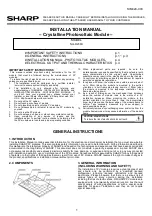
SIM424-003
3
17. Do not damage the surrounding PV modules or mounting
structure when replacing a PV module.
18. Bind cables by the insulation locks. Drooping down of
cables from the junction box could possibly cause various
problems such as animal biting, electricity leakage in
puddle.
19. Take proper measures for preventing the laminate
(consisted of resin, cells, glass, back sheet, etc.) from
dropping out of the frame in case the glass is broken.
20. Cables shall be located so that they will not be exposed
to direct sunlight after installation to prevent degradation
of cables.
21. If batteries are used with modules, follow safety
precautions of the battery manufacturer.
22. In case of extreme snow build-up, the weight of the snow
may cause the module’s frame to deform. Take
appropriate preventive measures to minimize any
possible resulting damage.
4. SITE SELECTION
In most applications, the PV modules should be installed in a
location where there is no shading throughout the year. In the
Northern Hemisphere, the PV modules should typically face
south, and in the Southern Hemisphere, the PV modules
should typically face north.
Please make sure that there are no obstructions in the
surroundings of the site of installation. TAKE PROPER
STEPS in order to maintain reliability and safety, in case the
PV modules are used in areas such as: Heavy snow areas /
Extremely cold areas / Strong wind areas / Installations over,
or near, water / Areas where installations are prone to salt
water damage/corrosive gas environment/ Small islands or
desert areas.
The results of the ammonia test and the salt-mist-corrosion
test on the modules, carried out under such strict test
conditions, should be disclosed for reference purposes only.
The decision on whether the modules are suitable and
compatible for each installation field will depend on the user’s
judgement and responsibility.
5. TILT ANGLE
The tilt angle is the measurement between the PV module
and a horizontal ground surface. The PV module generates
the maximum output power when it faces the sun directly.
5 degrees or more is recommended for the tilt angle of the PV
module for the maintenance. (See 9. Maintenance)
For the standalone systems with a battery where the PV
modules are attached to a permanent structure, the tilt angle
of the PV modules should be determined to optimize the
performance when the sunlight is the scarcest. In general, if
the electric power generation is adequate when the sunlight is
the scarcest, then the angle chosen should be adequate
during the rest of the year. For grid-connected installations
where the PV modules are attached to a permanent structure,
it is recommended to tilt the PV module at the angle equal to
the latitude of the installation site so that the power generation
from the PV module will be optimum throughout the year.
6. WIRING
To ensure proper system operation and to maintain your
guaranty, observe the correct cable connection polarity
(Figures 1) when connecting the modules to a battery or to
other modules. If not connected correctly, the bypass diode
could be destroyed.
PV modules can be wired in series to increase voltage.
Connect wires from the positive terminal of one module to the
negative terminal of the next module. Figure 1 shows modules
connected in series.
7. GROUNDING
The frame grounding must consider the local requirement
and regulation at the installation site. When grounding is
required, please refer to below example connection (Figure 3).
Please be careful in arranging the system ground so that the
removal of one module from the circuit will not interrupt the
grounding of any other modules.
The modules should be grounded to the same electrical point
as described below.
You can use a hole with the appropriate symbol for
equipotential bonding on the side frame for either a bolt, nut
and washer grounding the module to the frame, a ground lug
fastened by bolt or screw, or appropriate screw (hardware not
provided). An example of acceptable ground connection using
a bolt, nut and washer retaining a ground lug is shown in
figure 3. In a connection of this type, the hardware (such as a
toothed locked washer / star washer) must score the frame
surface to make positive electrical contact with the frame. The
ground wire must be considered within the local requirement
of local and regulation at the site of installation.
8. MOUNTING
Please make sure that all the information described in the
installation manual is still valid and proper for your installation.
The mounting method has been verified by SHARP and NOT
CERTIFIED by a third party organization.
The approved way to mount Sharp PV modules to a support
structure is described in this INSTALLATION MANUAL.
Although Sharp does not specify or warrant frame clips or
clamps, using frame clips (not provided) or clamps (not
provided) is possible when they are designed for PV modules
and with minimum dimensions on the sides of the module in
accordance with the instructions and drawings provided. If
using frame clips or clamps, the modules should be fixed
rigidly and there shall be no damage to the modules by
deforming mounting structure against design load.
The Sharp module guaranty may be void if customer-
selected frame clips are improper or inadequate for module
properties (including strength or material) or installation. Note
that if metal clips are used, there must be a path to ground
from the clips, (for instance, using star washers in the clip
hardware set).
Please review the descriptions and drawings carefully; not
mounting the modules according to one of these methods may
void your guaranty. These mounting methods are designed to
allow module loading of 2400Pa. Support structures that PV
modules are mounted on should be rigid. Sharp PV modules
are designed to ensure optimal electrical performance under
the condition that they are mounted on rigid support structures.
Deformation of support structure may damage PV module with
its electric performance.
When mounting the module on structure, ensure that no
corner has a displacement of more than 2mm per every
1000mm of the diagonal.
9. MAINTENANCE
The modules are designed for long life and require very little
maintenance. If the angle of the PV module is 5 degrees or
more, normal rainfall is sufficient to keep the module glass
surface clean under most weather conditions. If dirt build-up
becomes excessive, clean the glass surface preferably with
water only, or with wet soft sponge or cloth in case to remove
stubborn dirt. If cleaning the back of the module is required,
take utmost care not to damage the back side materials. In
order to ensure the operation of the system, check the
connection of wiring and the state of the jacket of wires
occasionally.






















